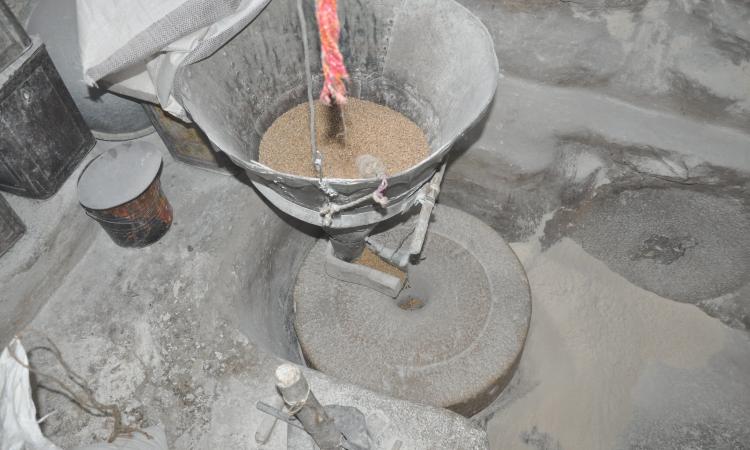
Traditional water mills can be a promising solution to Arunachal's growing power crisis
Villages in the hilly state of Arunachal Pradesh are experiencing an increased demand for power supply with increase in the tourism industry. According to the Central Electricity Authority (CEA), electricity consumption rose from 405 GWh in 2021 to 518 GWh in 2022 while the state’s electricity generation only marginally increased from 2.10 GWh in the previous fiscal year to 2.13 GWh in 2021-22, with the remaining demand being met through the regional grid. The CEA projects that the electricity consumption will reach 644 GWh by 2025-26 and 978 GWh by 2031-32 and will require careful planning and management of its energy resources.
Experts suggest that the overlooked indigenous practice of traditional watermills locally called as chhoskor could be a promising solution to alleviate the state’s power crisis. While being commonly used in many high-altitude regions across the country, these hydro-powered water mills or chhoskor have the potential to generate off-grid electricity. Many such neglected watermills have been revived and produce electricity in states like Uttarakhand and Himachal Pradesh, the potential of chhoskor in Arunachal Pradesh remains untapped.
A chhoskor can generate up to five kWh of electricity and operated by the power of flowing water, without any additional energy sources and requiring only one person for operation, this indigenous system is not only cost- and labour-efficient, but also sustainable in the long term. (Mongabay, India).
A village joins hands with the forest department to protect its bird visitors
Despite its status as a community reserve, the local community fears a decline in bird populations, attributed to factors like unstable weather conditions and urbanisation.
While efforts by the forest department and the villagers aim to uphold the village’s community reserve status, challenges such as loss of traditional practices like using bird droppings as fertiliser and a lack of interest in youth in conservation pose challenges.
Kokkarebellur, or Kokrebellur village with less than 1500 people in the Maddur district of Karnataka is well known for its birds. The name Kokkarebellur itself translates to “the hamlet of white storks”. Every year, hundreds of spot-billed pelicans and painted storks fly into the village, build nests, lay eggs and raise their chicks. On an average, 500 spot-billed pelicans and 2000 painted storks visit Kokkarebellur annually.
The villagers view the birds as akin to daughters, returning annually to their parental home to birth their brood. They also believe that the presence of the birds brings good fortune, while their absence foretells doom. Farmers also use the bird droppings as fertiliser.
The forest department has been involved in the conservation of trees and migratory birds in the village and villagers also join hands with the department and step forward to assist in emergencies. As an encouragement for local involvement in conservation efforts, the department compensates villagers who own large trees where the birds nest. A significant tamarind tree yields owners Rs. 3000 annually as they forgo harvesting during the bird migration season. A ficus tree is compensated at Rs. 1500 due to its leaves serving as fodder for livestock (Mongabay, India).
Long term monsoon forecasts help farmers cope with climate change: Study
The agriculture sector is highly sensitive to climate change and changing monsoon patterns are affecting agriculture in major ways. According to the World Bank, this puts 65 per cent of the world’s working poor, who depend on agriculture for their livelihoods, in jeopardy.
A study in Telangana has found that providing farmers with highly accurate information about the onset of monsoons can lead to a change in their behaviour on cropping patterns making such forecasts an important climate adaptation tool for the agricultural sector.
The researchers from University of Chicago tracked farmers across 250 villages in Medak and Mahabubnagar districts of Telangana. They looked into how the forecast information impacted their beliefs about the monsoon onset pre-harvest, their up-front investment decisions and their well-being at the end of the growing season. The study found strong evidence that the farmers changed their beliefs to be more in line with the forecast and highly valued this information. (Down To Earth).
Robot boats help clean polluted water bodies in India
The fight against water pollution in India is getting technological support from robot boats. Hongkong based marine tech startup Clearbot is using its fleet of autonomous vessels in Indian rivers and oceans to clean the waste in the waters and slove the probelm of water contamination. Co founded by Goel and Sidhant Gupta, the startup has already deployed 13 boats in India and Hong Kong and has successfully collected tons of waste. They are also planning on new generation vessels that will be bigger and will be able to process double the waste that is being currently processed.
A pilot project conducted in the city of Shillong showed that Clearbot could remove around 600 to 700 Kg of waste from a local lake within three days. Clearbot is also now being used in Bangalore and the company hopes to expand its operations further in India as huge volumes of trash are generated in water bodies in the country (Times of India).
This is a roundup of important news updates from 15th February to 29th February 2024. Read our policy updates here.
/articles/traditional-water-mills-solve-arunachals-growing-power-crisis